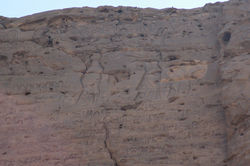
 |  |
|---|---|
 |  |
 |  |
 |  |
 |  |
 |  |
 |  |
 |
Amarna or Tell el-Amarna today was the city of Akhetaten (The Horizon of the Aten). In the fifth year of his reign, Akhenaten (Amenhotep IV, 1352-1336 BC) moved the royal residence to a previously uninhabited site in Middle Egypt. It was created for his revolutionary religion that worshiped Aten during the Amarna Period. The ancient capital of Akhetaten lies some 312 km south of Cairo in a natural amphitheater between inhospitable cliffs. This narrow opening exists for some twelve kilometers along the Nile River and has a half rounded depth of about five kilometers.
El-Amarna located on the eastern side of the Nile River, like all other ancient Egyptian capitals, was made up of temples, government establishments, utilitarian facilities such as grain silos and bakeries. The most impressive of the city today is Stelae U, which measures about 7.6 meters from top to bottom and occupies almost the entire height of the cliff in a little bay to the north of the entrance to the Royal Wadi. At the base of this Stelae on both sides are the remains of a group of carved statues of the Royal Family.
These Stelae give a vivid account of the king's selection and dedication of the site for his capital, following instructions from his father Aten when he illuminated a certain spot on the desert at sunrise. Much of the western side of the area, including houses, harbors and the main palace of the king, was obscured under the modern cultivation. However, there are a large number of structures that have been preserved in the desert to the east, and in general, most of the layout is discernable from foundations.
The Temples
Temples at Amarna are considerably different then most cult temples of ancient Egypt. They were solar temples, with the essential elements consisting of a small obelisk on a high base and an altar.
The Great Temple of the Aten
The Great Aten Temple is on the northern edge of the Central City. It is partly covered over by the modern cemetery of el-Till. The most basic element in the temple is the altar, to which a ramp or stairway ascends from the west in the middle of the court, surrounded by a temenos wall. The altar platform could occasionally be surrounded by a wall and fronted with a porch. The altar was usually surrounded by rows of offering tables. The court housing the altar could also be preceded by another court or more.
The enclosure wall for this temple extended back from the modern road for some 750 meters, and is now represented by a low, straight ridge. Within, the sanctuary was very similar to that in the Small Aten Temple and is marked by a group of isolated rubble heaps near the back.
The Small Temple of the Aten
This temple had a foundation layer of gypsum that is now covered over by sand. However, modern stone blocks have been laid atop the sand in order to provide the basic outlines of this temple.
A circular walk beginning at the middle of the north side of this small temple's enclosure wall reveals other parts of the Central City. There is a tall ridge of sand and some rubble that runs northward from across the street through the middle of a small palace built of mud brick. Known as the King's House, it probably accommodated the Royal Family on their visits. Behind the King's House and the Small Aten Temple were a group of government buildings built of mud brick. This is actually where the famous Amarna Letters were discovered by a peasant lady in 1888.
The Necropolises
The necropolis consists of more than twenty-five tombs facing the base of the cliff front that is located on the east side of the desert plain, which reaches a height of about eighty-five meters and south of the Royal Wadi Six tombs are located at the north side near Darb El-Malik and known as the North Tombs. These were probably tombs owned by fairly high officials, while nineteen more tombs are located in the south and known as the South Tombs. These southern tombs were owned by a mix of officials.
The Workers (or Eastern) Village
To the east in a little valley on the south side of a low plateau that runs out from the base of the cliffs between the Royal Wadi and the southern tombs there is an interesting settlement dubbed "the workmen's village". It is a walled enclosure of very regular houses along several parallel streets.
The Royal Tomb
The Royal Tomb built for Akhenaten lies in a narrow side valley leading off of the Royal Wadi some six kilometers from its mouth. Its basic design and proportions are not unlike those of the royal tombs in the Valley of the Kings on the West Bank at Thebes (modern Luxor). However, it was intended for several people, including the king, princes and probably Queen Tiy so there are additional burial chambers.
There is also an unfinished annex that may have been intended for Nefertiti. Here, the quality of the rock is poor, and so the decorations of the tomb were cut into a thin layer of gypsum plaster. Hence, most of the decorations have not survived and most of what is left is in the chambers of princess Meketaten.






